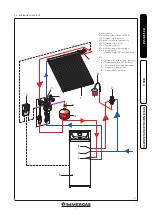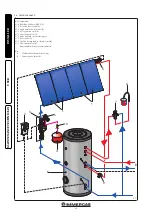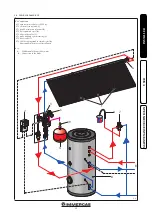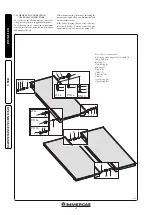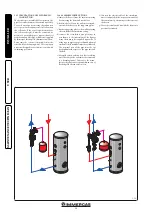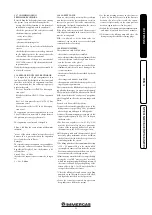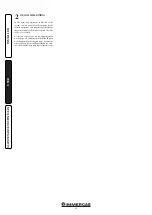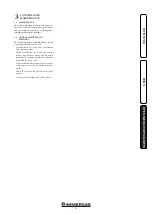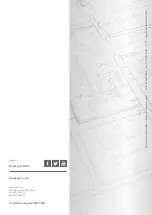
21
INS
TALLER
US
ER
MAINTEN
AN
CE TECHNI
CI
AN
1.17 COMMISSIONING.
PRELIMINARY CHECKS.
Before filling the hydraulic circuit and starting
the system, carry out the following checks:
- ensure that the declaration of conformity of
installation is supplied with the appliance;
- check the presence of the safety devices and
their functionality, particularly:
- safety valve (6 bar)
- expansion vessel
- thermostatic mixing valve
- check that there are no leaks in the hydraulic
circuit;
- check that there is an air vent valve positioned
in the highest point of the circuit above the
collector and that it is operational.
- check connection of the unit to a network of
230V-50Hz, correct L-N polarity and the earth-
ing connection;
If any checks/inspection give negative results, do
not start the system.
1.18 EXPANSION VESSEL PRE-CHARGE.
To compensate the high temperatures that
can be reached by the liquid in the circuit and
therefore its dilation, an expansion vessel has
been envisioned that has sufficient capacity to
perform this task.
- Kit 1 or 2 flat collectors CP4XL: 18 litre expan-
sion vessel
- Kit 4 flat collectors CP4XL: 35 litre expansion
vessel
- Kit 1 or 2 vacuum collectors CSV14: 35 litre
expansion vessel
- Kit 3 vacuum collector CSV14: 80 litre expan-
sion vessel.
The expansion vessels are supplied factory-set at
1 bar. It is therefore necessary to charge them to
the pressure necessary for the circuit.
The expansion vessel must be charged to:
2 bar + 0.1 bar for every metre of the water
column.
“metre of the water column” means the vertical
distance that is present between the expansion
vessel and the solar collector.
Example:
The circulation unit is found on the ground floor
and the solar collector is found on the roof at a
hypothetical height of 6 m, the distance to be
calculated is:
6 m x 0.1 bar = 0.6 bar
therefore the expansion vessel must be charged
to:
2 + 0.6 =
2.6 bar
1.19 SAFETY VALVE.
There is a safety valve present on the circulation
unit that protects the system from an excessive
increase in pressure. This valve intervenes by
discharging the liquid contained in the circuit
when the pressure reaches 6 bar.
If the safety valve intervenes and therefore part
of the liquid contained in the circuit is lost, this
must be re-integrated.
N.B.:
it is advised to fit the drain valve to a
container / can in order to recover the liquid
contained in the solar circuit.
1.20 FILLING SYSTEM.
The system can only be filled when:
- the system is completely assembled;
- any working residues have been eliminated that
cause obstructions and through time deterio-
rate the features of the glycol;
- all presence of water in the system has been
eliminated, which could cause damage to the
system in winter;
- the absence of leaks has been verified by checks
using air;
- the storage tank unit has been filled;
- the expansion vessel has been charged accord-
ing to system requirements.
The system must be filled only using the glycol
supplied by Immergas via an automatic pump.
The system must be filled with vent valve closed.
N.B.:
do not dilute the “ready to use” propylene
glycol supplied in the solar systems range with
water.
Proceed as follows to fill the system:
1 connect the automatic pump flow pipe to the
filling connector pipe (9 Fig. 1-14) positioned
above the pump and open the filling valve.
2 connect the automatic pump return pipe to the
input regulator pump (8 Fig. 1-14) and open
the drain valve.
3 The flow rate regulator screw (11 Fig. 1-14)
must be horizontal in order to guarantee
closure of the integrated ball valve. Leave the
thermometer in the (ON) reading position.
4 fill the pump tank with the amount of glycol
necessary plus a minimum stock to be left on
the bottom of the tank in order to prevent air
circulating inside the circuit.
5 The filling phase must have minimum duration
of 20 ÷ 25 minutes. This is the time needed
to completely remove all air from the circuit.
Every now and again open the flow rate regula-
tor aeration screw (vertical position).
6 Eliminate any air in the solar circuit preferably
using the so-called “pressure shot” method,
which consists in raising the filling pressure of
the circuit followed by a quick opening of the
return valve (8 Fig. 1-14). This method allows
to expel the air from the circuit.
7 Close the filling valve and switch the filling
pump off, open the regulator screw of the flow
rate regulator (notch in vertical position).
8 Leave the circuit pressurised. Any pressure
drop indicates a leak in the system.
9 Set the functioning pressure in the circuit at
2 bar + 0.1 bar for every metre in the distance
between the solar collector and the expan-
sion vessel (practically, set the same pressure
between expansion vessel and system).
10 Switch the solar pump on at a maximum speed
and make it function for at least 15 minutes.
11 Disconnect the filling pump and close the
fittings using the relevant screwing plugs.

